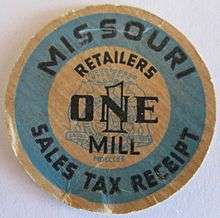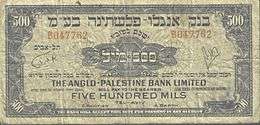Mill (currency)
The mill or (₥) (sometimes mil in the UK, when discussing property taxes in the United States, or previously in Cyprus and Malta) is a now-abstract unit of currency used sometimes in accounting. In the United States, it is a notional unit equivalent to 1⁄1000 of a United States dollar (a one-hundredth of a dime or a tenth of a cent). In the United Kingdom it was proposed during the decades of discussion on the decimalisation of the pound as a 1⁄1000 division of the pound sterling. Several other currencies used the mill, such as the Maltese lira.
The term comes from the Latin "millesimum", meaning "thousandth part".[1]
Usage
United States

In the United States, the term was first used by the Continental Congress in 1786, being described as the "lowest money of account, of which 1000 shall be equal to the federal dollar".[2]
The Coinage Act of 1792 describes milles and other subdivisions of the dollar:
That the money of account of the United States shall be expressed in dollars or units, dismes or tenths, cents or hundredths, and milles or thousandths, a disme being the tenth part of a dollar, a cent the hundredth part of a dollar, a mille the thousandth part of a dollar, and that all accounts in the public offices and all proceedings in the courts of the United States shall be kept and had in conformity to this regulation.[3]
The mint of Philadelphia made half cents worth 5 mills each from 1793 to 1857.
Tokens in this denomination were issued by some states and local governments (and by some private interests) for such uses as payment of sales tax.[4] These were of inexpensive material such as tin, aluminium, plastic or paper. Rising inflation depreciated the value of these tokens in relation to the value of their constituent materials; this depreciation led to their eventual abandonment. Virtually none were made after the 1960s.
Today, most Americans would refer to fractions of a cent rather than mills, a term which is widely unknown. For example, a gasoline price of $3.019 per gallon, if pronounced in full, would be "three dollars (and) one and nine-tenths cents". Discount coupons, such as those for grocery items, usually include in their fine print a statement such as "Cash value less than 1⁄10 of 1 cent". There are also common occurrences of "half-cent" discounts on goods bought in quantity. However, the term "mill" is still used when discussing billing in the electric power industry as shorthand for the lengthier "1⁄1000 of a dollar per kilowatt hour". The term is also commonly used when discussing stock prices, the issuance of founder's stock of a company, and cigarette taxes.
Property tax
Property taxes are also expressed in terms of mills per dollar assessed (a mill levy, known more widely in the US as a "mill rate"). For instance, with a millage rate of 2.8₥, a house with an assessment of $100,000 would be taxed (2.8 × 100,000) = 280,000₥, or $280.00. The term is often spelled "mil" when used in this context.[5]
Finance
The term mill is often used in finance, particularly in conjunction with equity market microstructure. The term is sometimes used as one-hundredth of a cent.[6] For example, a broker that charges 5 mils per share is taking in $5 every 10,000 shares traded. Additionally, in finance the term is sometimes spelled "mil".[7]
Some exchanges allow prices to be accounted in ten-thousandths of a dollar ($29.4125, for example). This last digit is sometimes called a "decimill" or "deci-mill", but no exchange officially recognizes the term.
Fiction
Mark Twain introduced a fictional elaboration of the mill in his 1889 novel A Connecticut Yankee in King Arthur's Court. When Hank Morgan, the American time traveler, introduces decimal currency to Arthurian Britain, he has it denominated in cents, mills, and "milrays", or tenths of a mill (the name perhaps suggested by "myriad", meaning ten thousand or by the Portuguese and Brazilian milreis).
Canada
Mills are or were formerly used in some cities to express property tax rates, in the same manner as in the U.S.
United Kingdom
Proposed on several occasions as a division of the British pound under the "Pound and Mil" system, the mill was occasionally used in accounting.
The 1862 report from the Select committee on Weights and Measures[8] noted that the Equitable Insurance Company had been keeping accounts in mills (rather than in shillings and pence) for such purposes for over 100 years. Such a unit of a thousandth of a pound would have also been similar in value to the then-existing farthing coin (worth 1⁄960 of a pound).
By the time British currency was decimalised in 1971, the farthing had been demonetised eleven years prior, in part due to having its value eroded by inflation; thus, the mill was no longer necessary.
Malta
Maltese lira coinage included 2 mil, 3 mil, and 5 mil coins from 1972 to 1994, with 10 mils being equal to one cent. While prices could still be marked using mils until 2008, when the country switched to the euro, in practice these were rounded off for accounting purposes.
Mandatory Palestine, Israel, Jordan

The Palestine pound, used as the currency of the British Mandate for Palestine from 1927 to 1948, was divided into 1,000 mils. Its successor currencies, the Israeli lira and the Jordanian dinar, were also divided into 1⁄1000 units, respectively named the pruta and fils. The Israeli pruta lasted until 1960, and the Jordanian fils until 1992.
Hong Kong
Between 1863 and 1866 the mill coin was the lowest denomination issued by the British government in Hong Kong; it was eliminated due to its unpopularity.[9]
Cyprus
The mill was used with the Cypriot pound, starting with decimalization in 1955, and lasting until 1983. However, coins smaller than 5 mils ceased being used in the mid 1960s. When switched to cents in 1983, a ½-cent coin was struck that was abolished a few years later.
Tunisia
Coins for 5 millimes (mills) are still in circulation. However, larger coins such as the 10, 20, 50, and 100 millime coins are still in use and production.
Similar units
- The Egyptian pound is divided into 1000 milliemes, and 10 milliemes equal 1 piastre.
- The Tunisian dinar is divided into 1000 millimes (10 millimes is the smallest currently-minted coin)
- The national currencies which are divided into 1000 fils are the Kuwaiti dinar (5 fils is the smallest currently-minted coin), Bahraini dinar (1 fils), Iraqi dinar (25 dinars). But as with the case of the United Arab Emirates dirham and the Yemeni rial, they are divided into 100 subunits.
- The Omani rial is divided into 1000 baisa.
- The Libyan dinar is divided into 1000 dirham since 1971.
- The Japanese yen was formerly divided into 100 sen or 1000 rin. An early proposed (but not accepted) design for the 1-rin coin used "1 mil" in the Romanized text
References
- Shorter Oxford English Dictionary, 6th Ed, Vol. 1, at 1782
- Journals of the Continental Congress, August 28, 1786
- U.S. Coinage Act of 1792
- Brian Rxm, "Sales Tax Tokens: US State issues during the 1930s Depression," Brian Rxm website
- "per mil symbol". Tech Target. Retrieved 2007-06-25.
- "SEC Market Structure Concept Release" (PDF). Tradeworx, Inc. p. 5. Retrieved 2014-10-26.
- "SEC Market Structure Concept Release" (PDF). Tradeworx, Inc. p. 5. Retrieved 2014-10-26.
- REPORT (1862) FROM THE SELECT COMMITTEE ON WEIGHTS AND MEASURES Archived 2009-06-09 at the Wayback Machine
- Ma Tak Wo 2004, Illustrated Catalogue of Hong Kong Currency, Ma Tak Wo Numismatic Co., LTD. Kowloon, Hong Kong.ISBN 962-85939-3-5